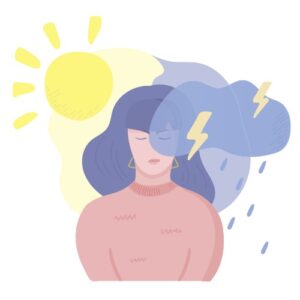
Sunshine, pool parties, backyard BBQs, clear blue skies, blooming flowers and picnics in the park come to mind when envisioning the much-anticipated summer season. But for some, as the temperatures rise and the sun comes out from hiding, so does increased stress and lowered moods. Seasonal affective disorder (SAD) is traditionally associated with crisp fall and frosty winter months—but its summer sibling can be just as dangerous. So what can you do if you’ve got a case of summertime SADness? Keep reading to learn more.
What is Seasonal Affective Disorder (SAD)?
Seasonal affective disorder (SAD)—also referred to as major depressive disorder with a seasonal pattern—is a mood disorder marked by recurrent episodes of depressive symptoms in late fall and winter or in the summer, with alternating periods of normal (non-depressive) moods during the rest of the year.
Research has shown that seasonal changes are the most likely cause of SAD because they can potentially cause chemical imbalances in the brain associated with depression and other mood disorders. However, the exact cause of seasonal affective disorder is unknown.
Low levels of vitamin D and shorter days are also a possible factor of SAD in colder months, while conversely, long hours of sunlight may cause SAD in warmer months.

Summer SAD vs. Winter SAD
Symptoms of seasonal affective disorder may start out mild but increase and become more noticeable as the season progresses. While both winter-pattern SAD and summer-pattern have some overlapping symptoms, there are key differences between the two.
General Seasonal Affective Disorder Symptoms:
- Feeling sad or in a low mood most of the time
- Feeling hopeless or worthless
- Having suicidal thoughts
- Losing interest in favorite hobbies and activities
- Decreased energy or feeling lethargic
- Having difficulty concentrating
- Decreased motivation
- Sleep disturbance
- Appetite changes
Additional Summer-Pattern SAD Symptoms:
- Difficulty falling asleep or staying asleep; insomnia
- Decreased appetite
- Weight loss
- Increased irritability or agitation
- Anxiety
- Episodes of violent behavior
Additional Winter-Pattern SAD Symptoms:
- Sleeping more than normal; oversleeping
- Tiredness and fatigue
- Increased appetite
- Regular cravings for foods that are high in fat or carbohydrates
- Weight gain
Those with bipolar disorder are at an increased risk of developing seasonal affective disorder, and can experience differing or additional symptoms of SAD than those without bipolar disorder.
An article by the Mayo Clinic states:
“In some people with bipolar disorder, episodes of mania may be linked to a specific season. For example, spring and summer can bring on symptoms of mania or a less intense form of mania (hypomania), anxiety, agitation and irritability. They may also experience depression during the fall and winter months.”

Treating Seasonal Affective Disorder (SAD)
If you’re experiencing symptoms of seasonal affective disorder, take them seriously. SAD can interfere with things such as school, work or interpersonal relationships, and can negatively affect your quality of life.
While it’s important to be mindful of the signs or symptoms you’re experiencing, you also shouldn’t self-diagnose because there could be other health issues at play.
A general physician can help you rule out other potential health issues, such as thyroid disorders, through medical tests (including blood tests). If your symptoms aren’t being caused by a thyroid disorder or other medical issue, a therapist and/or psychiatrist can provide a proper diagnosis and treatment.
At home options for managing symptoms are available, but should not be used as a replacement for medical intervention from a professional.
Tips for Managing Seasonal Affective Disorder Symptoms in the Summer:
#1 Identify Triggers
Watch out for and make note of triggers that cause a spike in your symptoms. Therapists are great at working with patients to identify triggers and come up with coping strategies around these triggers.
#2 Prioritize Sleep
Since decreased sleep and other sleep disturbances are a common symptom of summer-pattern SAD, extra work needs to be put into place to make sure we are sleeping well. Check out this blog post to learn how to create a solid sleep routine.
#3 Create a Daily Routine
Following a structured daily routine can help combat stress and improve focus. Write your routine down in a calendar or planner, set alarms to help you stay on schedule, display your routine throughout your home, and lean on loved ones to hold you accountable.
#4 Stay Cool
Use air-conditioning to improve your mood and sleep quality. If you have access to a lake, creek, river or pool, go for a swim. Limit time outside in the heat and exposure to sunlight, dress appropriately for the weather, and wear a sunhat. Find fun indoor activities (such as bowling or going to the movies) to fill your time.
#5 Drink Water—Lots of Water!
Dehydration can make us feel crappy in more ways than one, and can cause both physical and emotional health issues. When we drink enough water, it becomes easier to remain both physically, emotionally and mentally stable. Incorporate drinking water into your routine, keep a big water bottle with you at all times, and track how much water you’re drinking in comparison to how much water (at minimum) you should be drinking.
#6 Don’t Forget to Eat
Since decreased appetite is a symptom of SAD, it can be hard to make sure we’re nourishing ourselves properly during this time. Plan quick, healthy meals and snacks in advance and set alarms as reminders to eat.
Remember that what you’re feeling is normal! It can be extra hard to feel depressed during a time when we’re “supposed” to feel happy and have fun. Depression happens to a lot of us, and it can happen to anyone at any time. What you’re going through isn’t a choice, but you do have tools available to help you feel your best and manage your symptoms.
Therapy and medication management are effective ways to treat seasonal affective disorder. For further support, consider Valera Health’s virtual mental healthcare services which include individual therapy, group therapy, psychiatry, medication management and more.
Call 646-450-7748 to talk to a dedicated Health Connector who can help you start your wellness journey with a provider tailored to you.